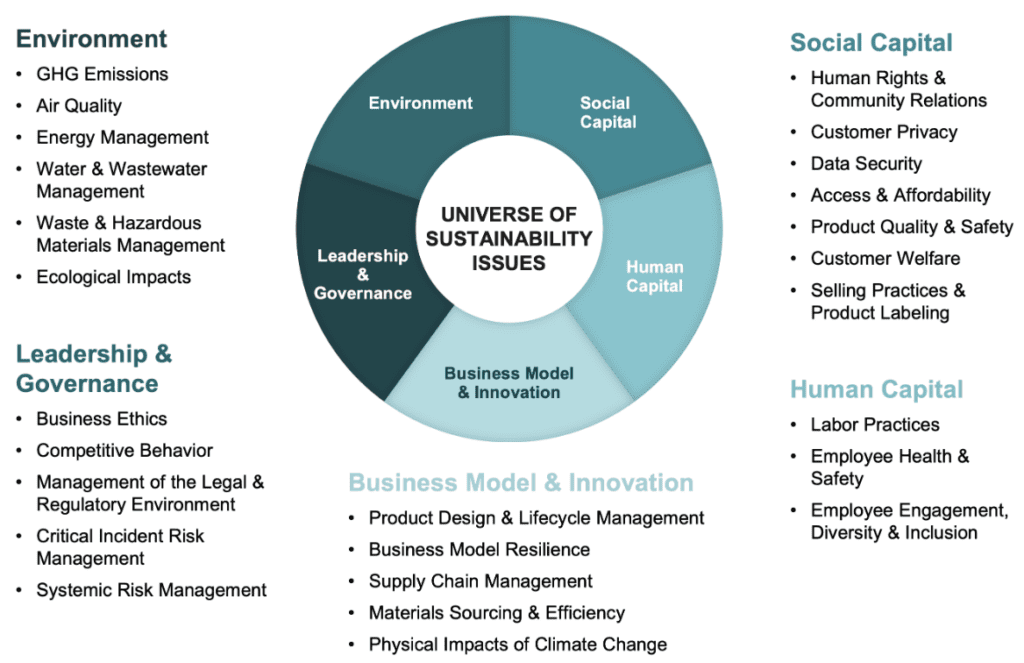ESG takes top priority on a company’s vision for the future. But what do corporate sustainability goals look like in practice?
With mounting pressure from investors and consumers, corporate sustainability has continued to mature beyond measurement and reporting toward more ambitious goal-setting. For example, in 2019, 90% of companies listed on the S&P 500® index issued an annual sustainability report, compared to just under 20% in 2011. As companies get more serious about sustainability, they have also started implementing and assessing bold ESG goals.
Often, these sustainability goals center on a company’s internal operations. Given that suppliers account for the majority of risk in areas such as GHG emissions, human rights abuses, and gaps in corporate governance, it is critical that companies explicitly target ESG goals in their supply chain. I recommend companies take tangible action toward setting supply chain ESG goals in the following ways:
1. Define Your Scope
As we know, corporate goals don’t always translate well to local suppliers. Therefore, companies should distill their goals down to actionable performance indicators. These KPIs should target specific supply chain issues that roll up to overarching sustainability goals.
For example, with 13 million hectares of forests being lost each year, one of Unilever’s goals was to address deforestation. “Ending deforestation within our supply chain is one of the biggest contributions Unilever can make to create a more sustainable world and maintain our consumers’ trust,” the company stated. This ambition translated into a goal to achieve a deforestation-free supply chain by 2023.
Unilever then aligned its goal with two United Nations Sustainable Development Goals (SDGs): #13: Climate Action, and #15: Life on Land. This helped the company focus its sustainability strategies on key international ESG issues, as well as to target metrics that investors and consumers now track.
For companies struggling to prioritize or identify their overarching goals, SASB’s materiality matrix is another excellent starting place. Although primarily designed for investors, the tool gives companies an overview of financially material ESG metrics for their industry.

Source: sasb.org
SASB’s at-a-glance view of priority ESG issues is comprised of five sustainability dimensions: Environment, Leadership and Governance, Business Model and Innovation, Social Capital, and Human Capital.
Once you’re able to identify the most material sustainability issues for your business, you can work to break them into tangible goals for your supply chain.
Next, companies must decide whether to set top-down or bottom-up ESG targets. Do you have goals that you will ask suppliers to meet, or will you work with suppliers to build personalized goals based on their abilities and needs? In its deforestation campaign, Unilever uses a mixture of carrot-and-stick measures to increase its chances for success.
2. Define Success
When high-achieving companies implement ESG strategies, they use quantitative, metrics-linked goals to measure whether they’ve reached their target. These goals fall into one of two primary types:
- Absolute goals, which only take KPIs into account—for example, reducing GHG emissions 30% by 2025
- Relative goals, which compare the KPI to a unit of output—for example, reducing Scope 1 GHG emissions per unit of company sales 25% by 2025
For instance, 74 Fortune Global 500 companies have set Science Based Targets (SBT), which are achieved when emissions are reduced in line with the goal of keeping warming below 2ºC. Of these, 58 have declared a target date (making it an absolute goal) for the necessary emissions reductions.
However, if your company wants to follow best practices, the UN SDG Compass, a business resource for achieving the SDGs, recommends that sustainability goals be linked to baseline and target dates.
- Measure KPIs by a point in time—we will increase the number of ESG-compliant suppliers by 40% by 2030.
- Measure KPIs by a period of time—we will decrease C02 emissions by 50% in the four-year period from 2021 to 2025.
Struggling to choose? As long as you remain realistic about your company’s abilities, set targets with clear, justifiable deadlines, and communicate the expectations to your suppliers, either method will help your company progress from scoping to the next step: strategy.
3. Specify Your Strategy
Which actions will you take to execute your newly-minted ESG goals? Whether you’re working with your suppliers directly or not, you cannot accomplish them alone. Here are some common first steps:
- Map your supply chain to understand high-level supplier risks.
- Communicate expectations about your new goals to all suppliers and solicit feedback.
- Begin baselining supplier performance according to their role in the supply chain.
- Work with high-priority suppliers to build capacity and discuss sustainability performance.
- Perform responsible sourcing audits on supply chain areas of deep concern.
- Create sustainability performance incentives and action plans with specific suppliers.
- Ask for help. If any of the steps above are beyond your area of expertise, seek partnerships or experts specific to your goals. For example, Earthworm Foundation helped Nestlé develop the first quantitative No Deforestation, Peat and Exploitation (NDPE) policy in the Palm Oil industry.
Recent technology has also made it much easier to map, audit, and collaborate with direct suppliers. At SupplyShift, for example, we help companies benefit from mapping supply chain transparency at any tier. For easy supplier tracking, companies use our Smart Assessments to instantly score supplier inputs, auto-calculate equations, and achieve more in-depth supply chain insights.
4. Secure Buy-In
Finally, companies must communicate their ESG scope, metrics, and strategies to the stakeholders who will make or break their initiatives. Three sectors of the supply chain have an outsized impact on corporate success:
- Procurement—are your goals realistic for divisions to execute?
- Leadership—do your goals reflect the strategic priorities of the organization? Are executives aligned to adequately support ESG?
- Suppliers—will they actively participate and contribute to your goals? How will you improve supplier buy-in?
In conclusion, a company’s supply chain ESG goals should prioritize specific sustainability achievements (such as those listed in the UN’s SDG Report or SASB’s Sustainability Matrix). They must also follow hard deadlines and KPI targets. In order to be successful, companies must communicate strategies to suppliers and allow information to flow both ways.
On a quarterly basis, for instance, Unilever regularly contacts an estimated 320 cocoa suppliers through its Global Traceability System to collect volume, sustainability, and visibility data.
Executives, take note: when you strive for ESG compliance and tackle global issues such as deforestation, carbon emissions, water scarcity, partnerships and collaborations are essential.
We’re here to help. If you’re seeking to take greater control over your supply chain visibility and ESG compliance, reach out to us to learn more about our supplier sustainability applications.




